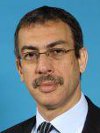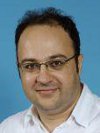

Signal waveform design for underwater acoustic communications
Dr Charalampos C. Tsimenidis
Newcastle University, School of Electrical, Electronic and Computer Engineering
Prof. Bayan S. Sharif
Newcastle University, School of Electrical, Electronic and Computer Engineering
Abstract
The tutorial will cover the design of signalling waveforms that are suitable for utilisation in underwater acoustic (UA) modems. These will include PN sequences with low auto and crosscorrelation properties, chirp design, in conjunction with pulse shaping and modulation schemes such as orthogonal frequency division multiple access (OFDM), direct sequence and multi-carrier code division multiple access (DS- and MC-CDMA). The tutorial will also address underwater channel modelling and simulation methodologies that are useful in evaluating "dry" performance of UA systems. Furthermore, the design of receiver algorithms will be considered that utilise adaptive receive arrays, carrier-phase and symbol timing recovery, Doppler compensation and multi-user detection methodologies. The tutorial is suitable for modem engineers with limited or no experience in this area to assist them in the design of UA based communication systems.
Extended Summary
In recent years, there has been an immense interest in developing underwater acoustic communication systems, most of which are related to remote control and telemetry applications. Other applications include ocean-bottom survey and collection of scientific data acquired by sub-sea sensors without the need for retrieving the equipment. However, for all these applications the principal function is to achieve reliable communication both in point-to-point links, and in network scenarios. In practice, the only feasible method to achieve sub-sea communications is by means of acoustic signals. Such acoustic links are exposed to adverse physical phenomena governing acoustic wave propagation in the sea. These include ambient noise, frequency-dependent attenuation, temperature and pressure variations, reverberation, and extended multi-path. Any successful acoustic modem design must consider all these effects in order to select an appropriate configuration for system-related parameters. The transmit power level and operating frequency must be considered in conjunction with the ambient noise and transmission range, the utilized modulation scheme, data rate, and the level of diversity must properly match the expected channel conditions related to time and frequency dispersion. Another key task is the choice of multiple-access strategy. The focus of this tutorial will be to investigate the design and analysis of receiver structures that employ well-established communication techniques, such as spatial and time filtering, in combination with the spread-spectrum principle. The presented receiver structures will provide a sound balance between efficient transmission and multiple-access capability.
Overview of the Underwater Acoustic Channel
A comprehensive review of the principles of propagation in multipath channels will be introduced whereby special emphasis will be placed in the description of the shallow-water acoustic channel. Terms such as rms delay spread, coherence bandwidth, Doppler spread and coherence time will be introduced to characterize the underwater channel and typical values for these parameters will be given derived from experimental data. The tutorial deals with both the characterisation and modelling as well as with the laboratory simulation of underwater acoustic based communication channels. Simulations can be used to evaluate the performance of receiver algorithms in communication systems, and thus avoid the costly process of physically conducting field trials on the candidate systems. Our approach to the problem will be to predict by means of computer simulation the impact of the channel on the desired transmitted waveform. Emphasis will be focused on the simulation of channels that exhibit both static and dynamic multipath-delay profiles. For dynamic channels, Rayleigh and Rician envelope variations will be mainly considered but also autoregressive modelling of the shallow water channel based on experimental data.
Signal Waveform Design
The tutorial will address issues related to the design of signaling waveforms that are suitable for utilization in underwater acoustic (UA) modems. These will include the design and generation of pseudo-noise (PN) sequences with low auto and cross-correlation properties that are employed in synchronization and training of the adaptive algorithms. Additionally, the design of Doppler tolerant chips will be discussed in conjunction with pulse shaping and multi-layered modulation schemes such as coded orthogonal frequency division multiple access (OFDM), direct sequence and multi-carrier code division multiple access (DS- and MC-CDMA).
Adaptive Algorithms for Single-Element Receiver Design
Receiver architectures will be diagrammatically introduced and discussed that are suitable for the underwater environment, whereby the differences and similarities to the radio wireless receivers will be highlighted. The minimum mean squared (MMSE) based receiver will be introduced for both single and multipleelement reception. The advantages and disadvantages resulting from the employment of this receiver in conjunction with adaptive spatial-diversity processing and adaptive equalization will be investigated.
Phase Tracking and Doppler Compensation
Furthermore, carrier phase recovery, timing and frame synchronization algorithms of both theoretical and practical interest will be introduced and discussed in detail along with provision of simulated and experimental results. Emphasis will be placed on Doppler compensation methods that are essential in receiver structures for underwater communications. Block and iterative based methodologies will be introduced and their performance will be demonstrated using experimental results.
Multi-channel Receivers
The use of spatial diversity is essential in underwater communications due to the low operational signal-to-noise ratio. Therefore, multi-element receiver structures that employ diversity combining methods will be introduced in this part and analysis will be provided and extended that is previously only available for mobile-radio channels and single-element reception. The tutorial will develop the use of spatial and temporal diversity combining techniques in conjunction with the DS/MC-CDMA principle and algorithms will be discussed that are required for initial detection of users, estimation of carrier phase and timing, Doppler compensation and efficient detection.
Biographies
Charalampos C. Tsimenidis is a Senior Lecturer in Signal Processing for Communications in the School of Electrical, Electronic, and Computer Engineering. He received his MSc with distinction and PhD from the University of Newcastle upon Tyne in 1999 and 2002, respectively. His main research interests are in the area adaptive array receivers for wireless communications including demodulation algorithms and protocol design for underwater acoustic channels. He has published over 90 conference and journal papers. During the last ten years he has made contributions in the area of receiver design to several European funded research projects including LOTUS, SWAN, and ACME.
Bayan S. Sharif is Professor of Digital Communications and Head of the School of Electrical, Electronic and Computer Engineering. He received the bachelor and doctorate degrees from Queen's University of Belfast and Ulster University, N. Ireland, in 1984 and 1988, respectively. He then held a Research Fellowship at Queen's University of Belfast before he was appointed as Lecturer at Newcastle University in 1990, and then as Senior Lecturer and Professor in Digital Communications in 1999 and 2000, respectively. Prof. Sharif has research interests in digital communications with a focus on wireless receiver structures and optimisation of wireless networks. He has published over 200 journal and conference papers, and held UK and EU research grants in digital communications, underwater acoustics and signal processing worth over £3M. He is a Chartered Engineer and Fellow of the IET.




